Monash University Buyer Behavior Analysis: Dove's Marketing Strategies
VerifiedAdded on 2022/11/17
|8
|2273
|3
Report
AI Summary
This report provides a comprehensive analysis of Dove's marketing strategies, focusing on their impact on consumer behavior. It examines Dove's approach to motivating female consumers, including the 'Real Beauty' campaign and its use of advertising channels such as the Super Bowl. The report delves into the effectiveness of these strategies, considering factors like consumer diversity, impulse buying, and the application of relevant theories such as the EKB model and motivation theory. It also discusses the potential drawbacks of Dove's marketing methods and whether the advertisements would resonate with men. The report concludes by evaluating the overall success of Dove's marketing efforts in reaching and influencing its target audience.
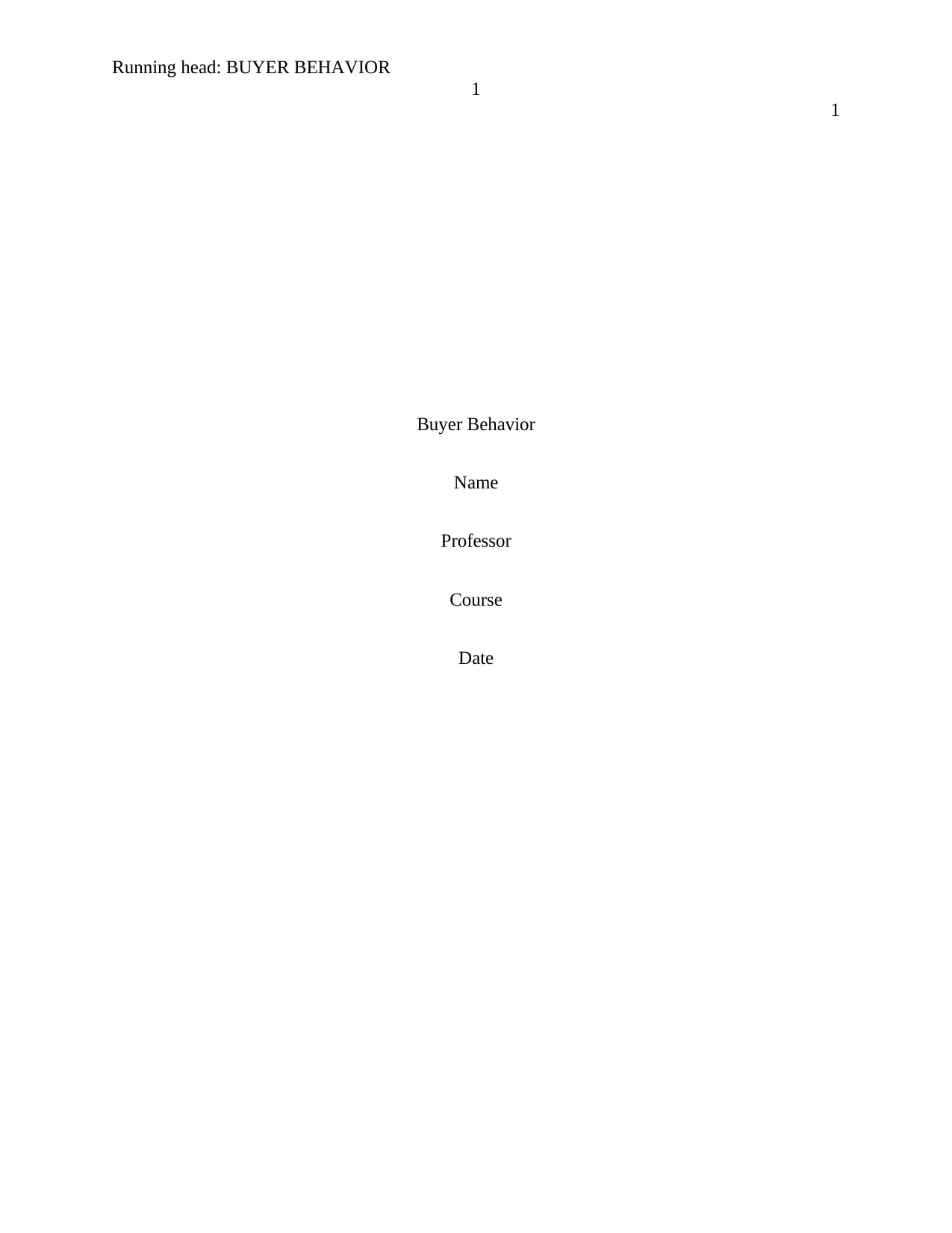
Running head: BUYER BEHAVIOR
1
1
Buyer Behavior
Name
Professor
Course
Date
1
1
Buyer Behavior
Name
Professor
Course
Date
Paraphrase This Document
Need a fresh take? Get an instant paraphrase of this document with our AI Paraphraser
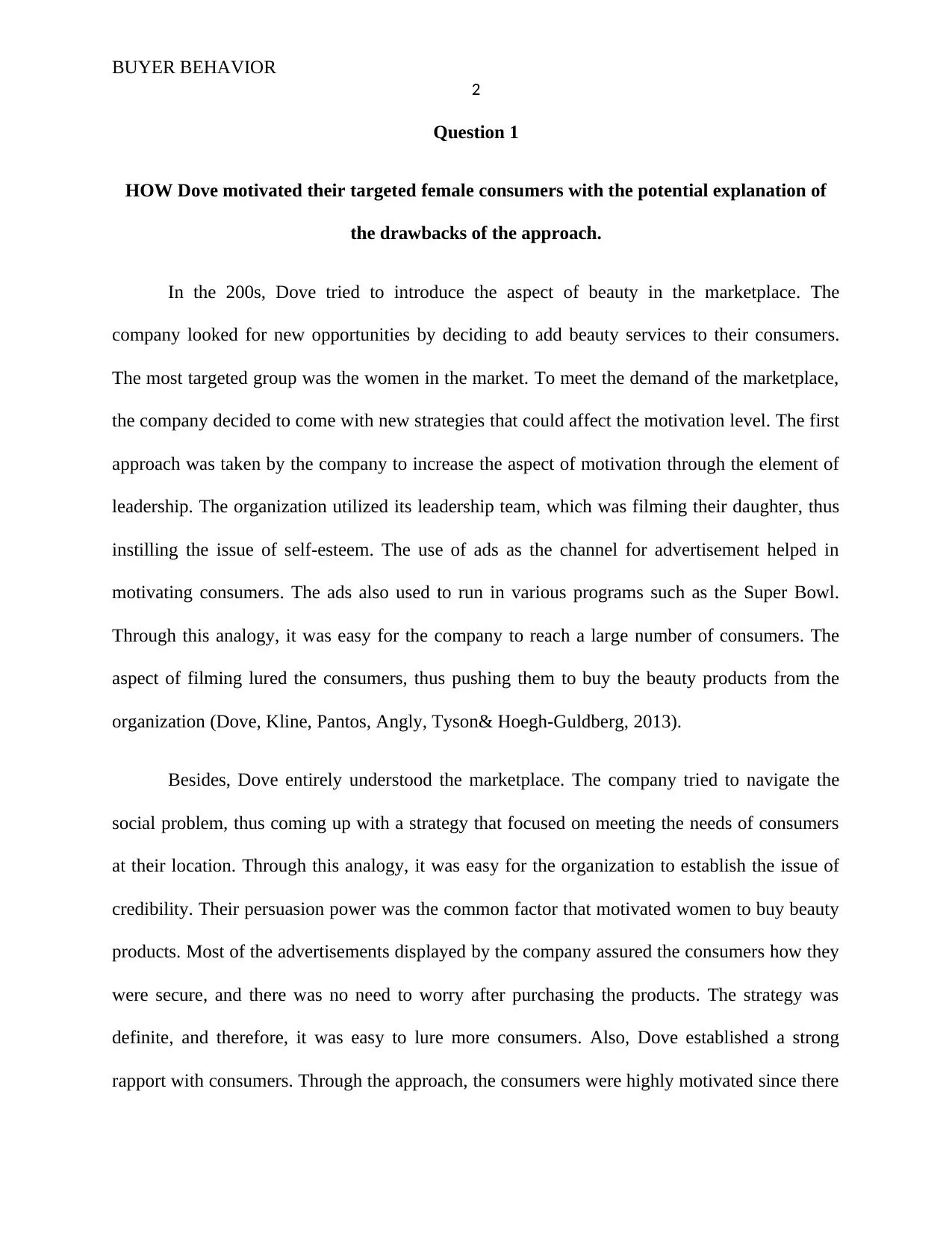
BUYER BEHAVIOR
2
Question 1
HOW Dove motivated their targeted female consumers with the potential explanation of
the drawbacks of the approach.
In the 200s, Dove tried to introduce the aspect of beauty in the marketplace. The
company looked for new opportunities by deciding to add beauty services to their consumers.
The most targeted group was the women in the market. To meet the demand of the marketplace,
the company decided to come with new strategies that could affect the motivation level. The first
approach was taken by the company to increase the aspect of motivation through the element of
leadership. The organization utilized its leadership team, which was filming their daughter, thus
instilling the issue of self-esteem. The use of ads as the channel for advertisement helped in
motivating consumers. The ads also used to run in various programs such as the Super Bowl.
Through this analogy, it was easy for the company to reach a large number of consumers. The
aspect of filming lured the consumers, thus pushing them to buy the beauty products from the
organization (Dove, Kline, Pantos, Angly, Tyson& Hoegh-Guldberg, 2013).
Besides, Dove entirely understood the marketplace. The company tried to navigate the
social problem, thus coming up with a strategy that focused on meeting the needs of consumers
at their location. Through this analogy, it was easy for the organization to establish the issue of
credibility. Their persuasion power was the common factor that motivated women to buy beauty
products. Most of the advertisements displayed by the company assured the consumers how they
were secure, and there was no need to worry after purchasing the products. The strategy was
definite, and therefore, it was easy to lure more consumers. Also, Dove established a strong
rapport with consumers. Through the approach, the consumers were highly motivated since there
2
Question 1
HOW Dove motivated their targeted female consumers with the potential explanation of
the drawbacks of the approach.
In the 200s, Dove tried to introduce the aspect of beauty in the marketplace. The
company looked for new opportunities by deciding to add beauty services to their consumers.
The most targeted group was the women in the market. To meet the demand of the marketplace,
the company decided to come with new strategies that could affect the motivation level. The first
approach was taken by the company to increase the aspect of motivation through the element of
leadership. The organization utilized its leadership team, which was filming their daughter, thus
instilling the issue of self-esteem. The use of ads as the channel for advertisement helped in
motivating consumers. The ads also used to run in various programs such as the Super Bowl.
Through this analogy, it was easy for the company to reach a large number of consumers. The
aspect of filming lured the consumers, thus pushing them to buy the beauty products from the
organization (Dove, Kline, Pantos, Angly, Tyson& Hoegh-Guldberg, 2013).
Besides, Dove entirely understood the marketplace. The company tried to navigate the
social problem, thus coming up with a strategy that focused on meeting the needs of consumers
at their location. Through this analogy, it was easy for the organization to establish the issue of
credibility. Their persuasion power was the common factor that motivated women to buy beauty
products. Most of the advertisements displayed by the company assured the consumers how they
were secure, and there was no need to worry after purchasing the products. The strategy was
definite, and therefore, it was easy to lure more consumers. Also, Dove established a strong
rapport with consumers. Through the approach, the consumers were highly motivated since there
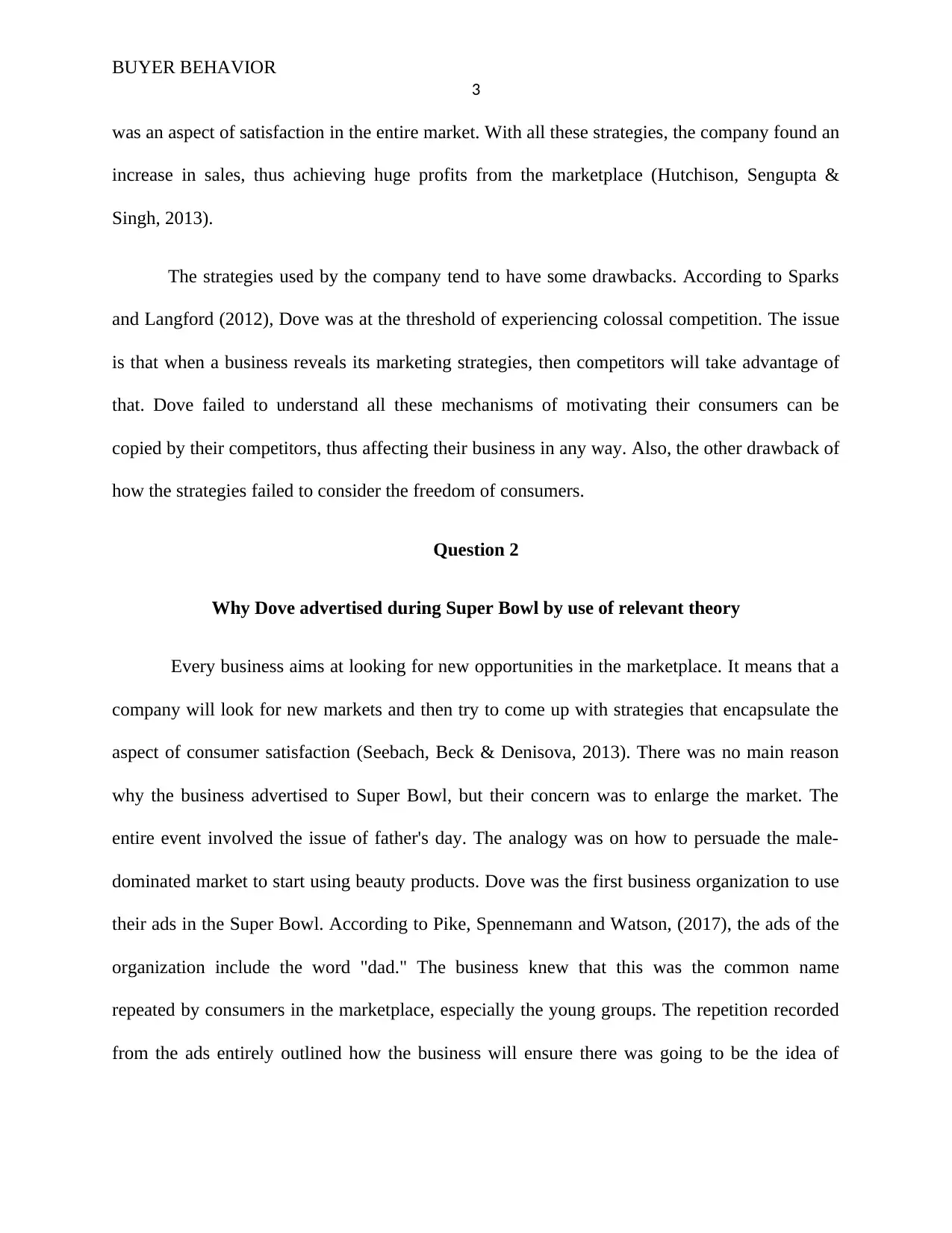
BUYER BEHAVIOR
3
was an aspect of satisfaction in the entire market. With all these strategies, the company found an
increase in sales, thus achieving huge profits from the marketplace (Hutchison, Sengupta &
Singh, 2013).
The strategies used by the company tend to have some drawbacks. According to Sparks
and Langford (2012), Dove was at the threshold of experiencing colossal competition. The issue
is that when a business reveals its marketing strategies, then competitors will take advantage of
that. Dove failed to understand all these mechanisms of motivating their consumers can be
copied by their competitors, thus affecting their business in any way. Also, the other drawback of
how the strategies failed to consider the freedom of consumers.
Question 2
Why Dove advertised during Super Bowl by use of relevant theory
Every business aims at looking for new opportunities in the marketplace. It means that a
company will look for new markets and then try to come up with strategies that encapsulate the
aspect of consumer satisfaction (Seebach, Beck & Denisova, 2013). There was no main reason
why the business advertised to Super Bowl, but their concern was to enlarge the market. The
entire event involved the issue of father's day. The analogy was on how to persuade the male-
dominated market to start using beauty products. Dove was the first business organization to use
their ads in the Super Bowl. According to Pike, Spennemann and Watson, (2017), the ads of the
organization include the word "dad." The business knew that this was the common name
repeated by consumers in the marketplace, especially the young groups. The repetition recorded
from the ads entirely outlined how the business will ensure there was going to be the idea of
3
was an aspect of satisfaction in the entire market. With all these strategies, the company found an
increase in sales, thus achieving huge profits from the marketplace (Hutchison, Sengupta &
Singh, 2013).
The strategies used by the company tend to have some drawbacks. According to Sparks
and Langford (2012), Dove was at the threshold of experiencing colossal competition. The issue
is that when a business reveals its marketing strategies, then competitors will take advantage of
that. Dove failed to understand all these mechanisms of motivating their consumers can be
copied by their competitors, thus affecting their business in any way. Also, the other drawback of
how the strategies failed to consider the freedom of consumers.
Question 2
Why Dove advertised during Super Bowl by use of relevant theory
Every business aims at looking for new opportunities in the marketplace. It means that a
company will look for new markets and then try to come up with strategies that encapsulate the
aspect of consumer satisfaction (Seebach, Beck & Denisova, 2013). There was no main reason
why the business advertised to Super Bowl, but their concern was to enlarge the market. The
entire event involved the issue of father's day. The analogy was on how to persuade the male-
dominated market to start using beauty products. Dove was the first business organization to use
their ads in the Super Bowl. According to Pike, Spennemann and Watson, (2017), the ads of the
organization include the word "dad." The business knew that this was the common name
repeated by consumers in the marketplace, especially the young groups. The repetition recorded
from the ads entirely outlined how the business will ensure there was going to be the idea of
You're viewing a preview
Unlock full access by subscribing today!
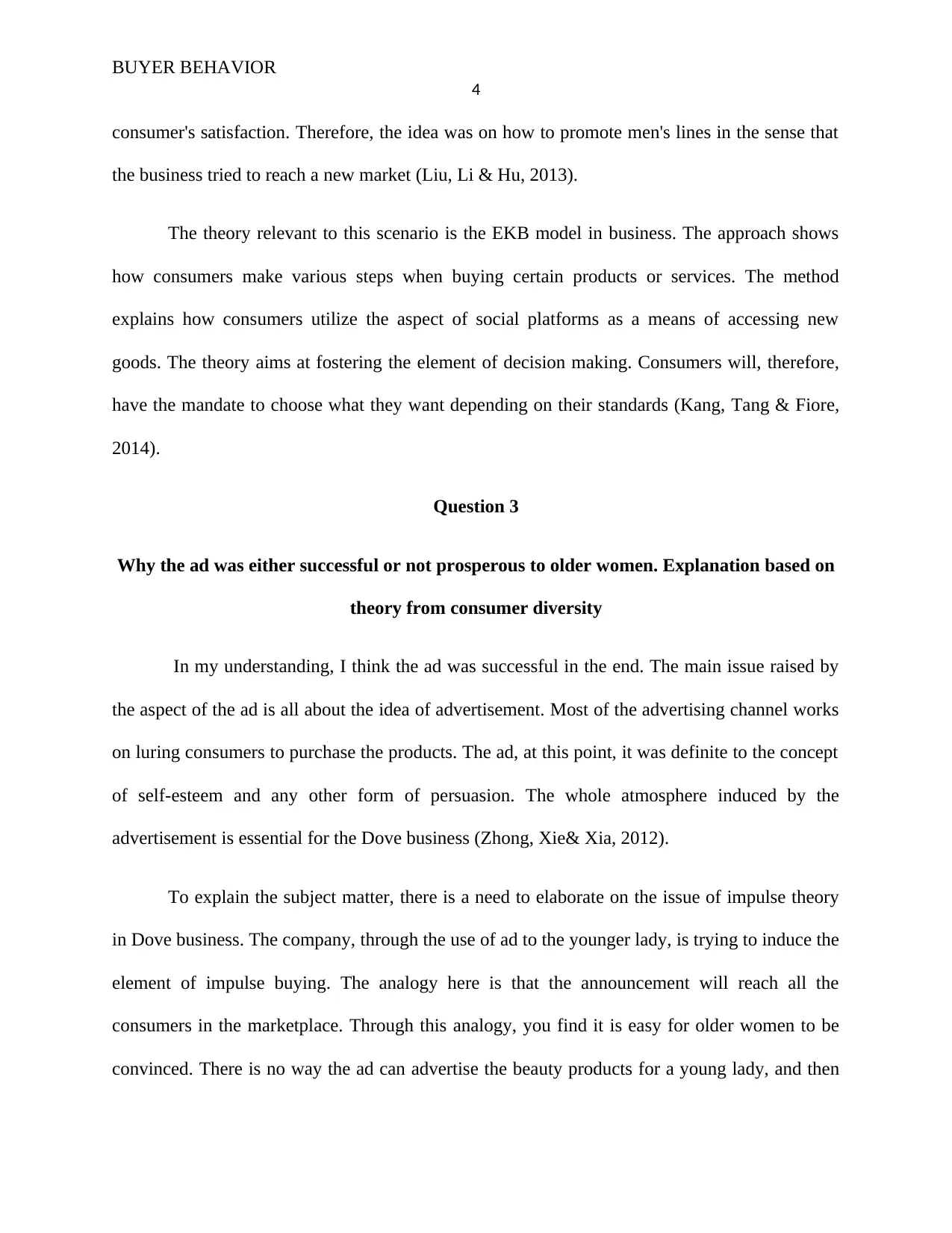
BUYER BEHAVIOR
4
consumer's satisfaction. Therefore, the idea was on how to promote men's lines in the sense that
the business tried to reach a new market (Liu, Li & Hu, 2013).
The theory relevant to this scenario is the EKB model in business. The approach shows
how consumers make various steps when buying certain products or services. The method
explains how consumers utilize the aspect of social platforms as a means of accessing new
goods. The theory aims at fostering the element of decision making. Consumers will, therefore,
have the mandate to choose what they want depending on their standards (Kang, Tang & Fiore,
2014).
Question 3
Why the ad was either successful or not prosperous to older women. Explanation based on
theory from consumer diversity
In my understanding, I think the ad was successful in the end. The main issue raised by
the aspect of the ad is all about the idea of advertisement. Most of the advertising channel works
on luring consumers to purchase the products. The ad, at this point, it was definite to the concept
of self-esteem and any other form of persuasion. The whole atmosphere induced by the
advertisement is essential for the Dove business (Zhong, Xie& Xia, 2012).
To explain the subject matter, there is a need to elaborate on the issue of impulse theory
in Dove business. The company, through the use of ad to the younger lady, is trying to induce the
element of impulse buying. The analogy here is that the announcement will reach all the
consumers in the marketplace. Through this analogy, you find it is easy for older women to be
convinced. There is no way the ad can advertise the beauty products for a young lady, and then
4
consumer's satisfaction. Therefore, the idea was on how to promote men's lines in the sense that
the business tried to reach a new market (Liu, Li & Hu, 2013).
The theory relevant to this scenario is the EKB model in business. The approach shows
how consumers make various steps when buying certain products or services. The method
explains how consumers utilize the aspect of social platforms as a means of accessing new
goods. The theory aims at fostering the element of decision making. Consumers will, therefore,
have the mandate to choose what they want depending on their standards (Kang, Tang & Fiore,
2014).
Question 3
Why the ad was either successful or not prosperous to older women. Explanation based on
theory from consumer diversity
In my understanding, I think the ad was successful in the end. The main issue raised by
the aspect of the ad is all about the idea of advertisement. Most of the advertising channel works
on luring consumers to purchase the products. The ad, at this point, it was definite to the concept
of self-esteem and any other form of persuasion. The whole atmosphere induced by the
advertisement is essential for the Dove business (Zhong, Xie& Xia, 2012).
To explain the subject matter, there is a need to elaborate on the issue of impulse theory
in Dove business. The company, through the use of ad to the younger lady, is trying to induce the
element of impulse buying. The analogy here is that the announcement will reach all the
consumers in the marketplace. Through this analogy, you find it is easy for older women to be
convinced. There is no way the ad can advertise the beauty products for a young lady, and then
Paraphrase This Document
Need a fresh take? Get an instant paraphrase of this document with our AI Paraphraser
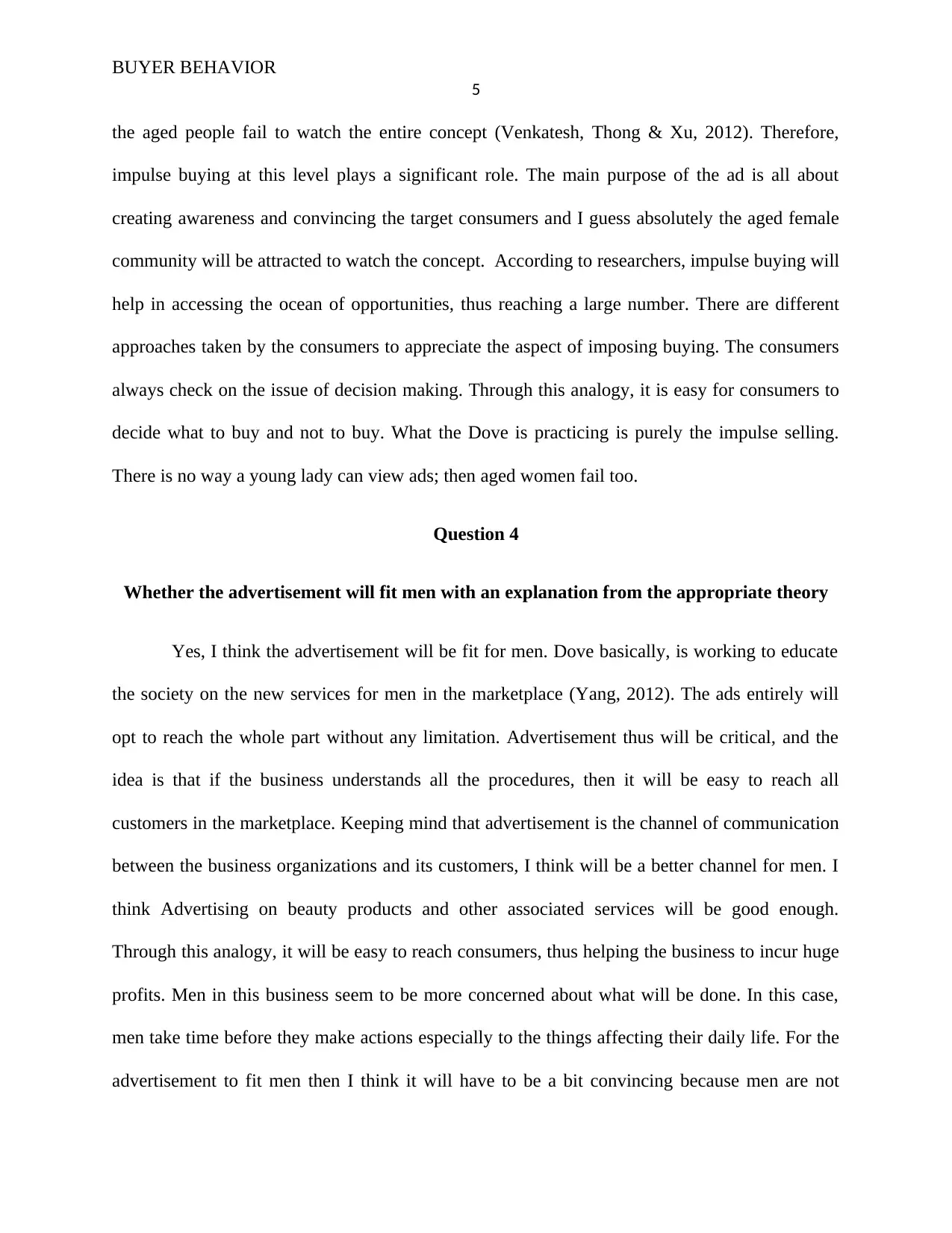
BUYER BEHAVIOR
5
the aged people fail to watch the entire concept (Venkatesh, Thong & Xu, 2012). Therefore,
impulse buying at this level plays a significant role. The main purpose of the ad is all about
creating awareness and convincing the target consumers and I guess absolutely the aged female
community will be attracted to watch the concept. According to researchers, impulse buying will
help in accessing the ocean of opportunities, thus reaching a large number. There are different
approaches taken by the consumers to appreciate the aspect of imposing buying. The consumers
always check on the issue of decision making. Through this analogy, it is easy for consumers to
decide what to buy and not to buy. What the Dove is practicing is purely the impulse selling.
There is no way a young lady can view ads; then aged women fail too.
Question 4
Whether the advertisement will fit men with an explanation from the appropriate theory
Yes, I think the advertisement will be fit for men. Dove basically, is working to educate
the society on the new services for men in the marketplace (Yang, 2012). The ads entirely will
opt to reach the whole part without any limitation. Advertisement thus will be critical, and the
idea is that if the business understands all the procedures, then it will be easy to reach all
customers in the marketplace. Keeping mind that advertisement is the channel of communication
between the business organizations and its customers, I think will be a better channel for men. I
think Advertising on beauty products and other associated services will be good enough.
Through this analogy, it will be easy to reach consumers, thus helping the business to incur huge
profits. Men in this business seem to be more concerned about what will be done. In this case,
men take time before they make actions especially to the things affecting their daily life. For the
advertisement to fit men then I think it will have to be a bit convincing because men are not
5
the aged people fail to watch the entire concept (Venkatesh, Thong & Xu, 2012). Therefore,
impulse buying at this level plays a significant role. The main purpose of the ad is all about
creating awareness and convincing the target consumers and I guess absolutely the aged female
community will be attracted to watch the concept. According to researchers, impulse buying will
help in accessing the ocean of opportunities, thus reaching a large number. There are different
approaches taken by the consumers to appreciate the aspect of imposing buying. The consumers
always check on the issue of decision making. Through this analogy, it is easy for consumers to
decide what to buy and not to buy. What the Dove is practicing is purely the impulse selling.
There is no way a young lady can view ads; then aged women fail too.
Question 4
Whether the advertisement will fit men with an explanation from the appropriate theory
Yes, I think the advertisement will be fit for men. Dove basically, is working to educate
the society on the new services for men in the marketplace (Yang, 2012). The ads entirely will
opt to reach the whole part without any limitation. Advertisement thus will be critical, and the
idea is that if the business understands all the procedures, then it will be easy to reach all
customers in the marketplace. Keeping mind that advertisement is the channel of communication
between the business organizations and its customers, I think will be a better channel for men. I
think Advertising on beauty products and other associated services will be good enough.
Through this analogy, it will be easy to reach consumers, thus helping the business to incur huge
profits. Men in this business seem to be more concerned about what will be done. In this case,
men take time before they make actions especially to the things affecting their daily life. For the
advertisement to fit men then I think it will have to be a bit convincing because men are not
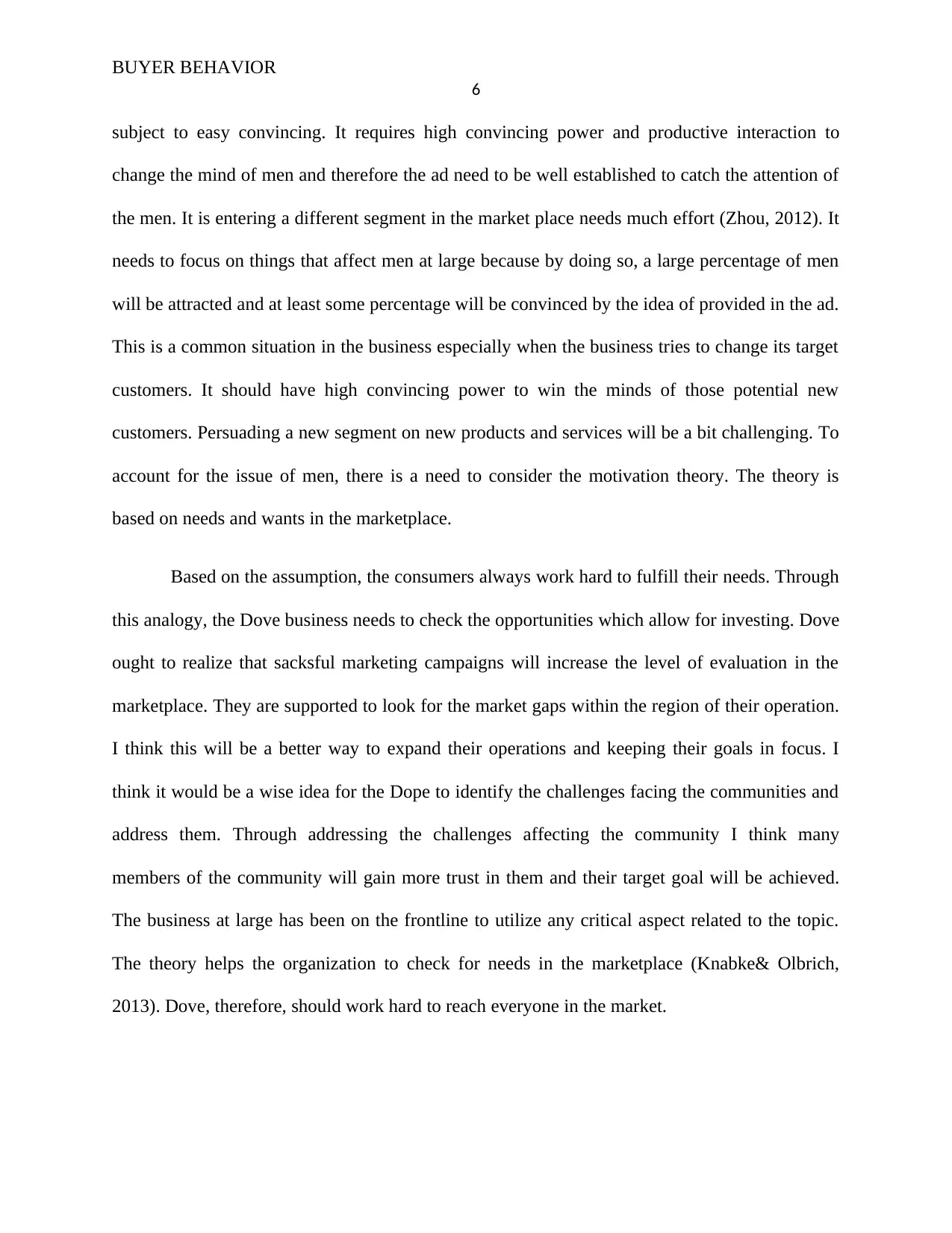
BUYER BEHAVIOR
6
subject to easy convincing. It requires high convincing power and productive interaction to
change the mind of men and therefore the ad need to be well established to catch the attention of
the men. It is entering a different segment in the market place needs much effort (Zhou, 2012). It
needs to focus on things that affect men at large because by doing so, a large percentage of men
will be attracted and at least some percentage will be convinced by the idea of provided in the ad.
This is a common situation in the business especially when the business tries to change its target
customers. It should have high convincing power to win the minds of those potential new
customers. Persuading a new segment on new products and services will be a bit challenging. To
account for the issue of men, there is a need to consider the motivation theory. The theory is
based on needs and wants in the marketplace.
Based on the assumption, the consumers always work hard to fulfill their needs. Through
this analogy, the Dove business needs to check the opportunities which allow for investing. Dove
ought to realize that sacksful marketing campaigns will increase the level of evaluation in the
marketplace. They are supported to look for the market gaps within the region of their operation.
I think this will be a better way to expand their operations and keeping their goals in focus. I
think it would be a wise idea for the Dope to identify the challenges facing the communities and
address them. Through addressing the challenges affecting the community I think many
members of the community will gain more trust in them and their target goal will be achieved.
The business at large has been on the frontline to utilize any critical aspect related to the topic.
The theory helps the organization to check for needs in the marketplace (Knabke& Olbrich,
2013). Dove, therefore, should work hard to reach everyone in the market.
6
subject to easy convincing. It requires high convincing power and productive interaction to
change the mind of men and therefore the ad need to be well established to catch the attention of
the men. It is entering a different segment in the market place needs much effort (Zhou, 2012). It
needs to focus on things that affect men at large because by doing so, a large percentage of men
will be attracted and at least some percentage will be convinced by the idea of provided in the ad.
This is a common situation in the business especially when the business tries to change its target
customers. It should have high convincing power to win the minds of those potential new
customers. Persuading a new segment on new products and services will be a bit challenging. To
account for the issue of men, there is a need to consider the motivation theory. The theory is
based on needs and wants in the marketplace.
Based on the assumption, the consumers always work hard to fulfill their needs. Through
this analogy, the Dove business needs to check the opportunities which allow for investing. Dove
ought to realize that sacksful marketing campaigns will increase the level of evaluation in the
marketplace. They are supported to look for the market gaps within the region of their operation.
I think this will be a better way to expand their operations and keeping their goals in focus. I
think it would be a wise idea for the Dope to identify the challenges facing the communities and
address them. Through addressing the challenges affecting the community I think many
members of the community will gain more trust in them and their target goal will be achieved.
The business at large has been on the frontline to utilize any critical aspect related to the topic.
The theory helps the organization to check for needs in the marketplace (Knabke& Olbrich,
2013). Dove, therefore, should work hard to reach everyone in the market.
You're viewing a preview
Unlock full access by subscribing today!

BUYER BEHAVIOR
7
7
Paraphrase This Document
Need a fresh take? Get an instant paraphrase of this document with our AI Paraphraser
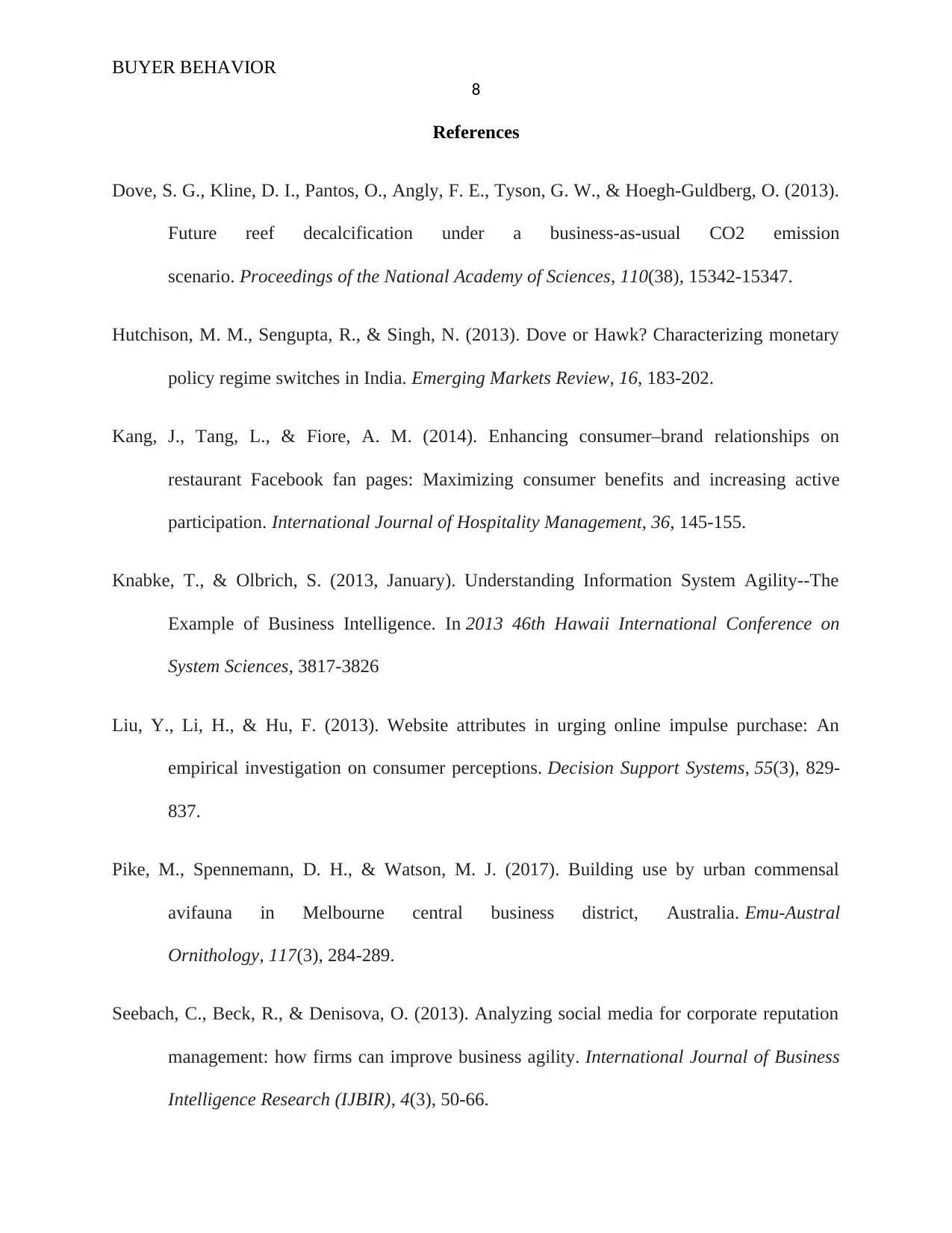
BUYER BEHAVIOR
8
References
Dove, S. G., Kline, D. I., Pantos, O., Angly, F. E., Tyson, G. W., & Hoegh-Guldberg, O. (2013).
Future reef decalcification under a business-as-usual CO2 emission
scenario. Proceedings of the National Academy of Sciences, 110(38), 15342-15347.
Hutchison, M. M., Sengupta, R., & Singh, N. (2013). Dove or Hawk? Characterizing monetary
policy regime switches in India. Emerging Markets Review, 16, 183-202.
Kang, J., Tang, L., & Fiore, A. M. (2014). Enhancing consumer–brand relationships on
restaurant Facebook fan pages: Maximizing consumer benefits and increasing active
participation. International Journal of Hospitality Management, 36, 145-155.
Knabke, T., & Olbrich, S. (2013, January). Understanding Information System Agility--The
Example of Business Intelligence. In 2013 46th Hawaii International Conference on
System Sciences, 3817-3826
Liu, Y., Li, H., & Hu, F. (2013). Website attributes in urging online impulse purchase: An
empirical investigation on consumer perceptions. Decision Support Systems, 55(3), 829-
837.
Pike, M., Spennemann, D. H., & Watson, M. J. (2017). Building use by urban commensal
avifauna in Melbourne central business district, Australia. Emu-Austral
Ornithology, 117(3), 284-289.
Seebach, C., Beck, R., & Denisova, O. (2013). Analyzing social media for corporate reputation
management: how firms can improve business agility. International Journal of Business
Intelligence Research (IJBIR), 4(3), 50-66.
8
References
Dove, S. G., Kline, D. I., Pantos, O., Angly, F. E., Tyson, G. W., & Hoegh-Guldberg, O. (2013).
Future reef decalcification under a business-as-usual CO2 emission
scenario. Proceedings of the National Academy of Sciences, 110(38), 15342-15347.
Hutchison, M. M., Sengupta, R., & Singh, N. (2013). Dove or Hawk? Characterizing monetary
policy regime switches in India. Emerging Markets Review, 16, 183-202.
Kang, J., Tang, L., & Fiore, A. M. (2014). Enhancing consumer–brand relationships on
restaurant Facebook fan pages: Maximizing consumer benefits and increasing active
participation. International Journal of Hospitality Management, 36, 145-155.
Knabke, T., & Olbrich, S. (2013, January). Understanding Information System Agility--The
Example of Business Intelligence. In 2013 46th Hawaii International Conference on
System Sciences, 3817-3826
Liu, Y., Li, H., & Hu, F. (2013). Website attributes in urging online impulse purchase: An
empirical investigation on consumer perceptions. Decision Support Systems, 55(3), 829-
837.
Pike, M., Spennemann, D. H., & Watson, M. J. (2017). Building use by urban commensal
avifauna in Melbourne central business district, Australia. Emu-Austral
Ornithology, 117(3), 284-289.
Seebach, C., Beck, R., & Denisova, O. (2013). Analyzing social media for corporate reputation
management: how firms can improve business agility. International Journal of Business
Intelligence Research (IJBIR), 4(3), 50-66.
1 out of 8
Your All-in-One AI-Powered Toolkit for Academic Success.
+13062052269
info@desklib.com
Available 24*7 on WhatsApp / Email
![[object Object]](/_next/static/media/star-bottom.7253800d.svg)
Unlock your academic potential
© 2024 | Zucol Services PVT LTD | All rights reserved.
